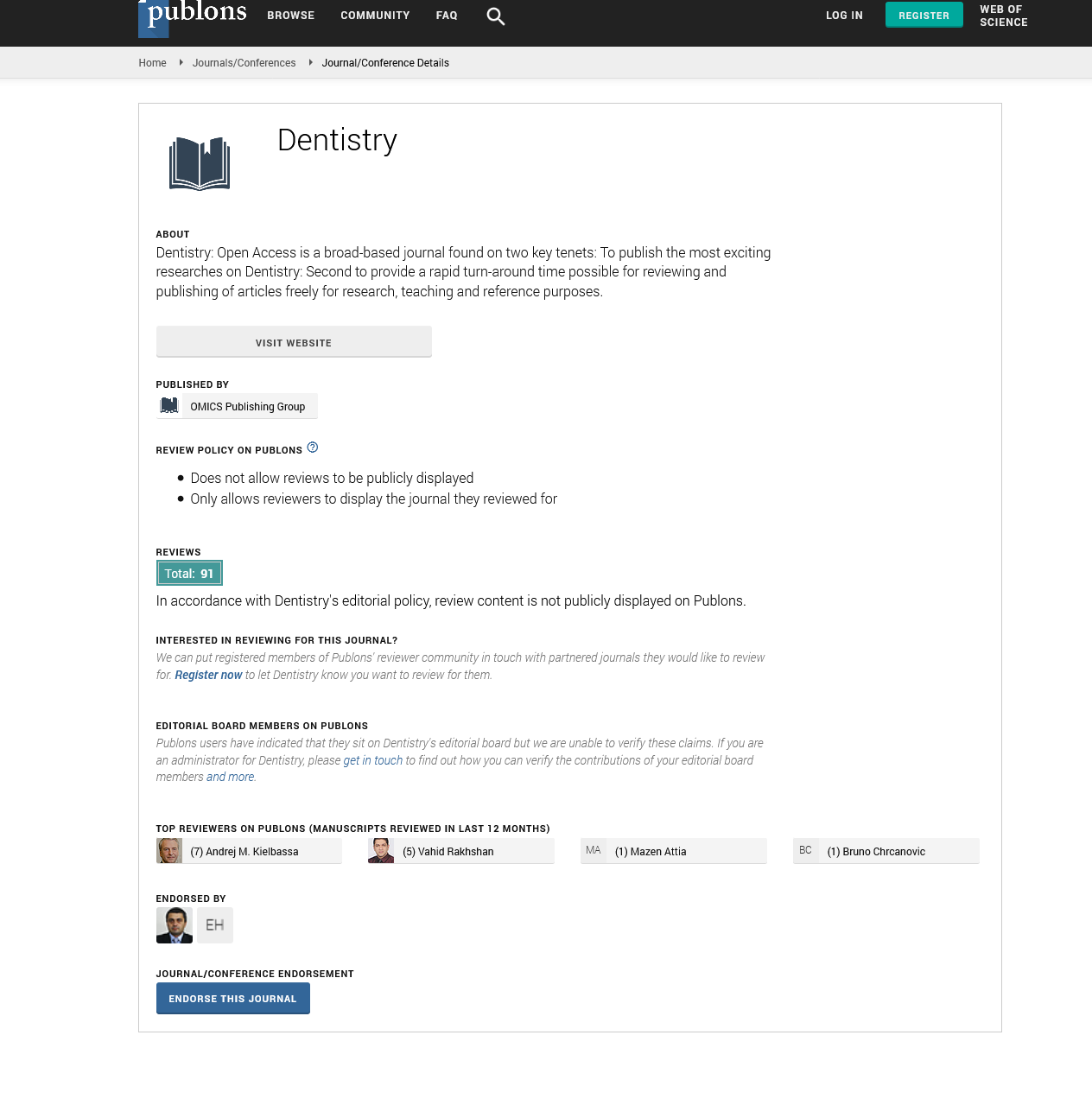Citations : 2345
Dentistry received 2345 citations as per Google Scholar report
Indexed In
- Genamics JournalSeek
- JournalTOCs
- CiteFactor
- Ulrich's Periodicals Directory
- RefSeek
- Hamdard University
- EBSCO A-Z
- Directory of Abstract Indexing for Journals
- OCLC- WorldCat
- Publons
- Geneva Foundation for Medical Education and Research
- Euro Pub
- Google Scholar
Useful Links
Share This Page
Journal Flyer

Open Access Journals
- Agri and Aquaculture
- Biochemistry
- Bioinformatics & Systems Biology
- Business & Management
- Chemistry
- Clinical Sciences
- Engineering
- Food & Nutrition
- General Science
- Genetics & Molecular Biology
- Immunology & Microbiology
- Medical Sciences
- Neuroscience & Psychology
- Nursing & Health Care
- Pharmaceutical Sciences
Perspective - (2023) Volume 13, Issue 1
Innovative Methods and Developing Trends in Oral and Maxillofacial Surgery
Aparicio Pinheiro*Received: 02-Jan-2023, Manuscript No. DCR-23-20892; Editor assigned: 05-Jan-2023, Pre QC No. DCR-23-20892 (PQ); Reviewed: 19-Jan-2023, QC No. DCR-23-20892; Revised: 26-Jan-2023, Manuscript No. DCR-23-20892 ; Published: 03-Feb-2023, DOI: 10.35248/2161-1122.23.13.622
About the Study
Oral and maxillofacial surgery is a rapidly evolving field that utilizes innovative methods to improve patient outcomes. Advancements in technology, surgical techniques, and materials have led to significant improvements in the field over the past few decades. In this article, we will explore some of the innovative methods and developing trends in oral and maxillofacial surgery.
Computer-Assisted Surgery (CAS)
Computer-Assisted Surgery (CAS) is a rapidly growing field in oral and maxillofacial surgery. The use of advanced imaging techniques, such as Computed Tomography (CT) and Magnetic Resonance Imaging (MRI), has enabled surgeons to plan and execute complex surgical procedures with greater accuracy and precision. The use of CAS in oral and maxillofacial surgery has significantly reduced the risk of surgical errors and complications.
One of the most significant benefits of CAS is the ability to perform minimally invasive surgery. With the use of small incisions and specialized instruments, surgeons can perform complex procedures with less pain, reduced scarring, and faster recovery times. Additionally, CAS has enabled surgeons to perform surgery in areas that were previously considered too difficult to access, such as the base of the skull.
3D printing
Three-Dimensional (3D) printing has revolutionized the field of oral and maxillofacial surgery by enabling the creation of patientspecific implants and surgical guides. Using 3D imaging technology, surgeons can create models of a patient's jaw, teeth, and surrounding tissue, which can be used to create custom implants and surgical guides. These implants and guides can be made from a variety of materials, including metals, ceramics, and plastics.
One of the most significant benefits of 3D printing is the ability to create implants that are perfectly tailored to the patient's anatomy. This results in improved outcomes, reduced complications, and faster recovery times. Additionally, 3D printing has enabled surgeons to create complex structures, such as dental prosthetics and bone grafts, with greater accuracy and precision.
Robotic surgery
Robotic surgery is another developing trend in oral and maxillofacial surgery. The use of robots in surgery has been shown to improve surgical outcomes, reduce complications, and shorten recovery times. Robotic surgery is particularly useful in performing procedures that require a high level of precision, such as the removal of tumors and the placement of dental implants.
One of the most significant benefits of robotic surgery is the ability to perform surgery with greater accuracy and precision. Robots can perform complex movements and manipulations that are difficult or impossible for human hands to replicate. Additionally, robotic surgery can be performed through small incisions, resulting in less pain, reduced scarring, and faster recovery times.
Platelet-Rich Plasma (PRP) therapy
Platelet-Rich Plasma (PRP) therapy is a developing trend in oral and maxillofacial surgery that utilize the patient's blood to promote healing and reduce inflammation. PRP therapy involves extracting a small amount of the patient's blood, which is then processed to concentrate the platelets. The concentrated platelets are then injected into the site of the surgery to promote healing.
One of the most significant benefits of PRP therapy is the ability to promote healing and reduce inflammation. This results in faster recovery times and reduced postoperative pain. Additionally, PRP therapy can be used to treat a variety of oral and maxillofacial conditions, including bone loss, gum disease, and jaw pain.
Virtual Reality (VR)
Virtual Reality (VR) is a developing trend in oral and maxillofacial surgery that allows surgeons to visualize and plan surgical procedures in a virtual environment. VR technology allows surgeons to create a virtual model of the patient's jaw and surrounding tissue, which can be used to plan and practice surgical procedures before they are performed on the patient.
Citation: Pinheiro A (2023) Innovative Methods and Developing Trends in Oral and Maxillofacial Surgery. J Dentistry. 13:627.
Copyright: © 2023 Pinheiro A. This is an open access article distributed under the terms of the Creative Commons Attribution License, which permits unrestricted use, distribution, and reproduction in any medium, provided the original author and source are credited.

